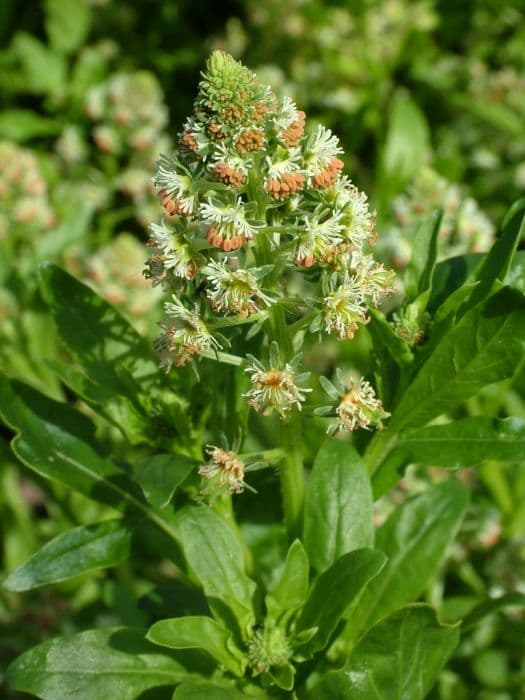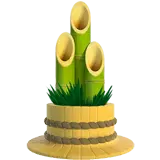Reseda odorata

ABOUT
Reseda odorata, commonly known as mignonette, is a flowering plant noted for its sweet fragrance. The mignonette boasts lance-shaped, light green leaves that are arranged in a rosette at its base. As the plant matures, the leaves may climb up the stem, becoming smaller and less conspicuous. The flowers of the mignonette are quite small and typically colored in subtle shades of white or yellowish-green. They are grouped closely together on long, slender, erect spikes, giving the blooms an attractive, feathery appearance. Each individual flower bears petals that are somewhat nondescript, often with rolled edges, which contributes to their delicate look. The blooms exude a strong, pleasant scent that is most pronounced in the evening or at night, making it a favorite among gardeners who value olfactory delights in their gardens. Overall, the mignonette's charm lies in its simplicity and the delightful aroma it adds to its surroundings.
About this plant
 Names
NamesFamily
Resedaceae.
Synonyms
Mignonette, Sweet Reseda, Garden Mignonette, Sweet Mignonette.
Common names
Reseda baetica, Reseda suffruticulosa, Glauca suffruticosa, Reseda virens, Reseda ramosissima, Reseda alba, Reseda incarnata, Reseda latifolia, Reseda grata, Reseda scheereri
 Toxicity
ToxicityTo humans
Reseda odorata, commonly known as mignonette, is generally considered non-toxic to humans. There are no significant reports of poisoning or serious side effects from ingesting parts of the mignonette plant. However, it is always advisable to exercise caution and avoid consuming plant material that is not known to be edible.
To pets
Mignonette is also regarded as non-toxic to pets, with no significant reports of poisoning in animals such as cats and dogs from ingesting parts of the plant. Owners should still prevent pets from eating ornamental plants as a precautionary measure, and any unusual symptoms following ingestion should prompt a consultation with a veterinarian.
 Characteristics
CharacteristicsLife cycle
Annuals
Foliage type
Deciduous
Color of leaves
Green
Flower color
White
Height
1-3 feet (0.3-0.9 meters)
Spread
0-1 foot (0-0.3 meters)
Plant type
Herb
Hardiness zones
7
Native area
Mediterranean
Benefits
 General Benefits
General Benefits- Aesthetic Appeal: Reseda odorata, commonly known as mignonette, has delicate green foliage and clustered white or yellow flowers that add a charming aesthetic to gardens and landscapes.
- Fragrance: The mignonette is renowned for its sweet and strong fragrance, which can perfume an entire garden area, particularly in the evenings.
- Attracts Pollinators: Mignonette flowers are known to attract bees and other pollinating insects, benefitting the overall health of the garden ecosystem.
- Historical Significance: It has been cultivated for centuries, lending historical and heritage value to gardens and horticultural collections.
- Easy to Grow: Mignonette is considered easy to cultivate from seed, making it a suitable choice for novice gardeners and those who prefer low-maintenance plants.
- Compatibility with Other Plants: The plant can be easily integrated into flower borders and beds alongside other annuals and perennials, creating a diverse garden arrangement.
- Cut Flowers: Its long-lasting and fragrant flowers are excellent for cutting and using in floral arrangements indoors.
- Educational Interest: Gardeners interested in historical and heirloom plants often grow mignonette, making it a source of educational interest in the cultivation of traditional varieties.
 Medical Properties
Medical PropertiesThis plant is not used for medical purposes.
 Air-purifying Qualities
Air-purifying QualitiesThis plant is not specifically known for air purifying qualities.
 Other Uses
Other Uses- As a natural dye: Mignonette (Reseda odorata) leaves and flowers can be used to produce a yellow dye for fabrics and yarns.
- In potpourri: The dried flowers of Mignonette are often included in potpourri mixtures due to their sweet fragrance.
- In perfumery: The essential oils derived from Mignonette can be used in making natural perfumes.
- As a flavoring agent: The flowers of Mignonette have been used to flavor drinks and confectionaries, though this is not common.
- In insect repellent: The scent of Mignonette may naturally deter certain insects, hence it can be planted in gardens for this purpose.
- In sachets: Dried Mignonette flowers can be placed in sachets to keep linens and clothes smelling fresh.
- As a garden companion plant: Mignonette can provide a beneficial environment for certain vegetables by attracting pollinators to the garden.
- In floral arrangements: Fresh Mignonette flowers are sometimes used in bouquets and floral arrangements for their fragrance and delicate appearance.
- As an educational tool: Mignonette is used in botany classes to demonstrate plant growth and pollination due to its distinct features.
- In crafts: Pressed Mignonette flowers can be used in crafting and scrapbooking to add a natural element to various projects.
Interesting Facts
 Feng Shui
Feng ShuiMignonette is not used in Feng Shui practice.
 Zodiac Sign Compitability
Zodiac Sign CompitabilityMignonette is not used in astrology practice.
 Plant Symbolism
Plant Symbolism- Fragrance: Reseda odorata, commonly known as mignonette, is renowned for its sweet and strong fragrance, symbolizing a person's attraction to others through their natural charm and personality.
- Memories: The mignonette's lasting scent is often associated with the remembrance of past events and loved ones, invoking nostalgia and cherished moments.
- Consolation: Given as a gift, mignonette can represent consolation, offering comfort and solace to someone who is grieving or going through a difficult time.
- Perseverance: This plant's ability to thrive in diverse conditions and its continuous bloom is symbolic of perseverance and the ability to persist despite challenges.
- Simple Pleasures: The unassuming appearance of mignonette contrasts with its delightful scent, symbolizing the appreciation of simple pleasures and understated beauty.
 Water
WaterMignonette should be watered regularly, especially during prolonged dry spells, to keep the soil evenly moist but not waterlogged. It typically requires watering every week, but this can vary depending on climate conditions and soil type. Approximately one to two gallons of water per week should suffice, adjusting for rainfall and high temperatures which may require more frequent watering. Ensure that the water reaches deep into the soil to encourage a strong root system. Avoid overhead watering to prevent fungal diseases; instead, water directly at the base of the plant.
 Light
LightMignonette thrives in full sun to partial shade. The best spot for planting mignonette is an area that receives at least four to six hours of direct sunlight daily. However, in regions with very hot summers, some afternoon shade can help protect the plant from excessive heat.
 Temperature
TemperatureMignonette prefers a temperature range between 60°F and 75°F. It can tolerate a minimum temperature of 40°F and a maximum of around 90°F. For optimal growth, maintain consistent temperatures within the ideal range; extreme fluctuations can stress the plant.
 Pruning
PruningMignonette benefits from occasional pruning to remove faded flowers and encourage bushier growth. Pruning should be done after the main blooming period, typically in late summer. Regular deadheading of spent blooms can also promote a second flush of flowers. Prune lightly, as overly aggressive cutting can damage the plant.
 Cleaning
CleaningAs needed
 Soil
SoilMignonette (Reseda odorata) thrives best in rich, well-draining soil with a pH ranging from 6 to 7.5. A good mix would be 2 parts garden soil, 2 parts peat moss or compost, and 1 part sand or perlite to ensure proper drainage.
 Repotting
RepottingMignonette (Reseda odorata) typically does not require frequent repotting and can be done every 2 to 3 years. It is best to repot when the plant has outgrown its current pot or the soil has become compacted.
 Humidity & Misting
Humidity & MistingMignonette (Reseda odorata) does well in average room humidity, but benefits from a boost in moisture. Aim for a humidity level around 40-50% for optimal growth conditions.
 Suitable locations
Suitable locationsIndoor
Place Mignonette in a sunny spot and water when soil is dry.
Outdoor
Plant Mignonette in full sun and well-draining soil.
Hardiness zone
7-9 USDA
 Life cycle
Life cycleReseda odorata, commonly known as Mignonette, begins its life cycle when seeds are sown in well-draining soil during spring or late autumn. After germination, which takes 10 to 15 days, seedlings develop into rosettes of blue-green lance-shaped leaves. As the plant grows, it develops a central stem and starts branching, eventually reaching up to 18 inches in height. The Mignonette produces small, fragrant, greenish-white flowers from midsummer to fall, which are attractive to pollinators. After pollination, the flowers develop into small rounded capsules containing tiny seeds. The plant completes its cycle when these seeds mature and are released, falling to the ground or collected for propagation, and the plant then dies, being an annual species.
 Propogation
PropogationPropogation time
Spring to summer
Mignonette, commonly known as Reseda odorata, can be propagated most effectively through seeds. The prime time to sow Mignonette seeds is in early spring, typically after the danger of frost has passed. To propagate, seeds should be scattered on well-prepared soil and lightly covered with soil. Water the area gently to moisten the soil without disturbing the seeds. The seeds normally germinate within 10 to 15 days, depending on the soil temperature and conditions. It is important to keep the soil consistently moist but not waterlogged during germination and early growth to foster healthy development of the plants. Mignonette prefers a sunny location with well-drained soil for optimal growth once established.